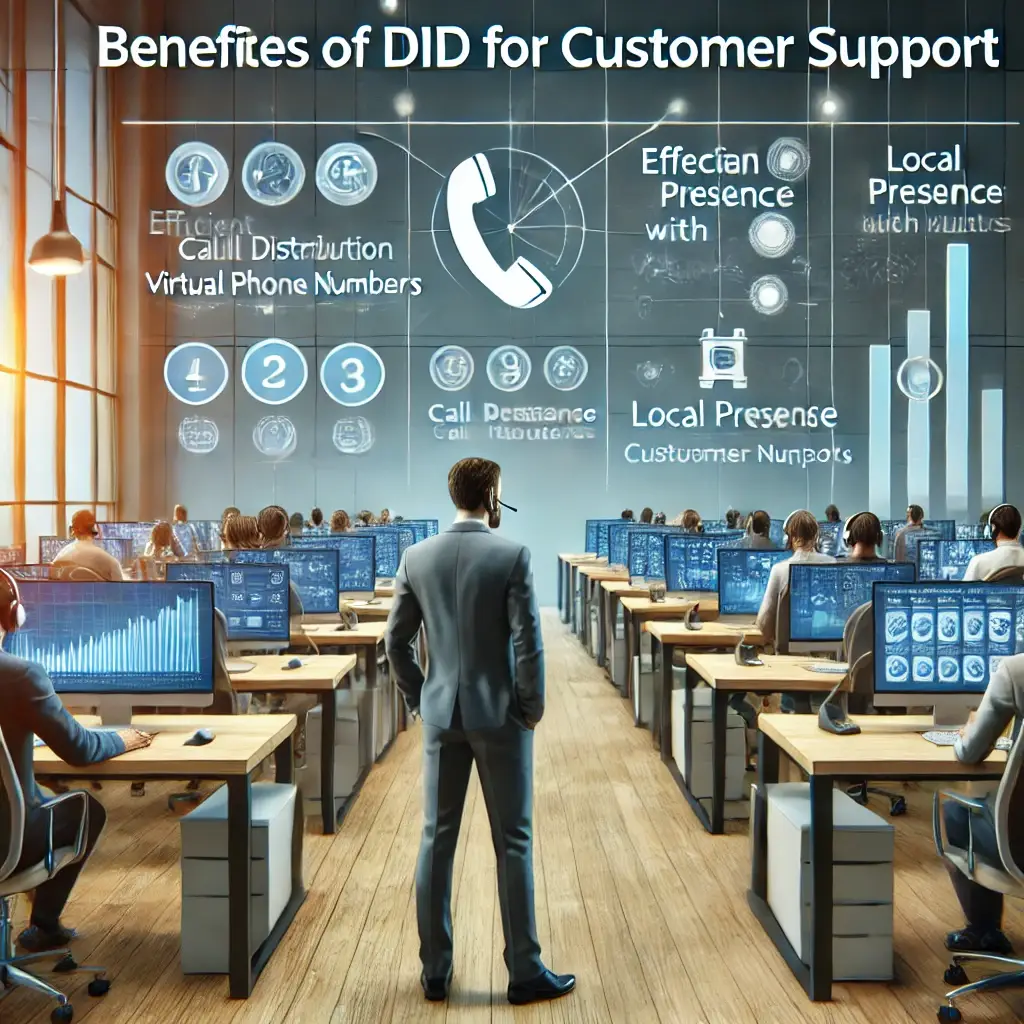Direct Inward Dialing (DID) for Customer Support
Key Takeaways on Direct Inward Dialing for Customer Support
-DID (Direct Inward Dialing) enables businesses to provide direct phone numbers for individual employees or departments without requiring separate physical phone lines.
– Virtual phone numbers streamline call management and enhance customer experience by offering local presence and toll-free options.
– Call routing through DID allows efficient call distribution to the right agents, improving response times.
– PBX (Private Branch Exchange) systems integrate seamlessly with DID, providing scalability and multi-line support.
– VoIP (Voice over Internet Protocol) technology paired with DID ensures cost-effective and flexible communication solutions.
-Extension numbers and IVR (Interactive Voice Response) systems enhance call management and customer satisfaction.
-Call analytics offer insights into customer interactions, aiding in better decision-making and service improvements.
What is Direct Inward Dialing (DID)?
Direct Inward Dialing (DID) is a telecommunication service that allows a company to allocate individual phone numbers to each employee or department without requiring multiple physical phone lines. This technology leverages virtual phone numbers to streamline communication and enhance customer experience. DID numbers are typically integrated with PBX systems, enabling efficient call routing and management.
Key Features of DID:
– Individual phone numbers for employees.
– Integration with PBX and VoIP systems.
– Cost-effective call management.
– Local and toll-free number options.

Benefits of DID for Customer Support
Using DID for customer support offers numerous advantages, including improved call management, enhanced scalability, and better customer experience. With DID, businesses can ensure that calls are efficiently routed to the right agents, reducing wait times and increasing customer satisfaction.
Advantages:
– Efficient call distribution.
– Enhanced scalability with multi-line support.
– Better call management with extension numbers.
– Improved customer experience with IVR systems.

Implementing DID in Your Business
To implement DID in your business, consider partnering with a reliable VoIP and PBX provider. Assess your current call management needs and choose a DID service that offers scalability and advanced features. Integration with your existing VoIP system can further enhance the efficiency of your communication infrastructure.
Steps to Implement DID:
– Evaluate your business needs.
– Choose a reliable DID provider.
– Integrate with existing VoIP and PBX systems.
– Train staff on using DID features.

Best Practices for Using DID
To maximize the benefits of DID, follow best practices such as regular call analytics review, efficient call routing, and maintaining a seamless communication system. Utilize features like call forwarding and voicemail to ensure no customer inquiry goes unanswered.
Best Practices:
– Regularly review call analytics.
– Optimize call routing strategies.
– Ensure seamless communication integration.
– Utilize advanced DID features like call forwarding and voicemail.

Conclusion: Direct Inward Dialing (DID) for Customer Support
Direct Inward Dialing (DID) is a powerful tool for enhancing customer support. By providing individual phone numbers and integrating with PBX and VoIP systems, DID offers improved call management, scalability, and customer satisfaction. Implementing DID with a reliable provider can streamline communication, reduce costs, and support business growth. By following best practices and leveraging advanced features, businesses can ensure seamless and efficient customer interactions.
FAQs: Direct Inward Dialing (DID) for Customer Support
Q: What is Direct Inward Dialing (DID)?
A: Direct Inward Dialing (DID) is a telecommunication service that provides individual phone numbers for employees or departments without requiring separate physical phone lines.
Q: How does DID improve customer support?
A: DID enhances customer support by enabling efficient call routing, reducing wait times, and offering local and toll-free number options, thus improving customer satisfaction.
Q: Can DID be integrated with VoIP systems?
A: Yes, DID can be seamlessly integrated with VoIP systems, providing a cost-effective and flexible communication solution.
Q: What are the key features of DID?
A: Key features of DID include individual phone numbers for employees, integration with PBX systems, cost-effective call management, and options for local and toll-free numbers.
Q: How do I choose a DID provider?
A: When choosing a DID provider, consider factors such as reliability, scalability, advanced features, and integration capabilities with existing VoIP and PBX systems.
Additional Readings
Ultimate Guide to Setting Up DID
Comparing Direct Inward Dialing Providers
DID Boosting Productivity and Efficiency
Troubleshooting Common DID Issues
The Future of DID: Trends and Predictions
Cost-effective DID Alternatives for Small Business
How Businesses Grow with DID Numbers